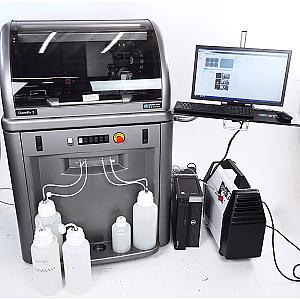The Fortebio ClonePix 2 cell counter is an effective medical device designed for precise cell counting and analysis in biological samples. With its advanced technology, it provides reliable and efficient results for medical research and diagnostics. Its ergonomic design and ease of use make the cell counting process more convenient and accurate. The ClonePix 2 is an essential tool for laboratories and healthcare professionals seeking an effective and reliable solution for cellular analysis.
Mammalian colony picker ClonePix 2 - Good Condition







Offer Details
Accessories :
Molecular Devices ClonePix 2 Mammalian Colony Säugerzelllinie-Kolonie Picker
Options :
5512
Description
Picking Single-Cell Derived Clones Made Easy: Streamlining Workflow with ClonePix 2
The Mammalian Colony Picker ClonePix 2 represents a significant advancement in clone screening technology, offering enhanced capabilities for researchers seeking efficient and reliable methods for clone selection. Building upon the proven workflow of its predecessor, the ClonePix 2 system now integrates high-resolution single-cell imaging capability on day 0, providing researchers with a comprehensive view of isolated single cells in both XY and Z dimensions.
With its rapid Z-stack acquisition feature, the enhanced ClonePix 2 system captures over 2,400 high-resolution Z-plane images per microwell, swiftly compiling them into an image stack. This advanced imaging technology allows for the detection of single cells throughout the medium volume, not limited to a single focal plane, on day 0. By obtaining detailed images of individual cells at an early stage, researchers can gather valuable data to inform their clone selection process.
On the day of picking, colonies of interest are identified based on productivity data generated from the enhanced ClonePix 2 system. These colonies' origins can be traced back to the single-cell images captured on day 0, enabling seamless assessment of a colony's monoclonality and productivity prior to picking. This integration of imaging data with clone selection enhances the confidence in clone selection and reduces the screening time from two rounds to one.
Moreover, the simplified workflow offered by the ClonePix 2 system streamlines the process from single-cell identification to productivity screening, all within one comprehensive system. By providing image-based evidence of clonality and productivity, the ClonePix 2 system empowers researchers with efficient tools for clone selection, ultimately accelerating the pace of research and discovery in mammalian cell culture applications.
The enhanced capabilities of the Mammalian Colony Picker ClonePix 2 make the process of picking single-cell derived clones significantly easier and more efficient. By associating single-cell image data acquired on day 0 to the subsequent colony growth, researchers gain valuable insights into the origin of each clone prior to picking. This association is facilitated by the system's advanced algorithm, which assigns a monoclonality confidence score to all high-value clones. With this information at hand, users can confidently select clones that are monoclonally derived, ensuring the integrity and consistency of their experiments.
This enhanced ClonePix approach represents a significant improvement in clone selection methodology, as it eliminates the need for a second round of cloning to demonstrate clonality. By providing comprehensive data on clone origin and monoclonality upfront, the system streamlines the entire clone selection process, reducing timelines by half. This reduction in time is particularly advantageous for researchers working on time-sensitive projects or aiming to accelerate their research and development efforts. Overall, the enhanced ClonePix 2 system offers researchers a more efficient and reliable solution for picking single-cell derived clones, ultimately advancing the pace of scientific discovery in mammalian cell culture applications.
Features
- High-resolution single-cell imaging capability
- Rapid Z-stack acquisition feature
- Comprehensive view of isolated single cells
- Identification of colonies based on productivity data
- Tracing colony origins back to single-cell images
- Monoclonality confidence score assignment
- Streamlined workflow from single cell identification to productivity screening
Technical Details
- Weight: 350 kg
- Dimensions: 101,0 x 90,0 x 149,0 cm
Compatible Accessories
Attention: For information on compatible accessories, please refer to the PDF.